 Image search results - "new" Image search results - "new" |

Nagahama Hachimangu Shrine torii on New Year's Day. Nagahama's most popular shrine for New Year's worship (hatsumode). MAP
|
|

Tokyo Shiga Kenjinkai New Year's Party 2007 平成19年 東京滋賀県人会 新年賀詞交歓会Party fee was 7,000 yen.
|
|

National Diet members in Tokyo representing Shiga Prefecture. 滋賀の議員
|
|

Path to shrine with stone lanterns, and cars.
|
|

Each Diet member gave a short speech.
|
|

Stone lanterns
|
|
|
|

Buffet dinner in Providence Hall, Tokyo Prince Hotel
|
|

The shrine grounds was filled with cars on New Year's Day. Apparently, the shrine has no parking lot.
|
|

Buffet
|
|

Another entrance to the shrine
|
|

Mochi-tsuki 餅つき大会
|
|
|

Mochi for all, dressing was grated daikon and dried bonito shavings.
|
|
|

Live orchestra playing swing jazz. 有川新二&ザ・グレイ・ラスカルズオーケストラ「なつかしのスウイングジャズ」
|
|

Haiden hall 拝殿
|
|

Drawing for prizes donated by Shiga businesses. 抽選会
|
|

Ice sculpture of two rats. 2008 is the year of the rat.
|
|

Prizes. 抽選会の景品
|
|
|

People come to claim their prizes. 景品を受ける
|
|

Honden Hall 本殿
|
|

Consolation prize for people who didn't win anything. 当たらなかった人にも残り少々の景品
|
|

New Year's prayers amid snow.
|
|

Singing "Biwako Shuko no Uta" 琵琶湖周航の歌
|
|

Buying omikuji fortune paper
|
|

Singing "Biwako Shuko no Uta"
|
|

Shrine souvenirs
|
|

Singing "Biwako Shuko no Uta" in a large circle.
|
|

Votive tablet
|
|

Banzai
|
|
|

Everyone got to take home a gift bag of negi green onions, mochi, and other goodies.
|
|
|

Gift bags.
|
|

Torii to Benzaiten Shrine
|
|

Benzaiten Shrine
|
|

Benzaiten Shrine
|
|

Torii to Tenmangu Shrine 天満宮
|
|

Tenmangu Shrine 天満宮
|
|
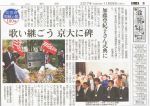
Chunichi Shimbun article (Nov. 26, 2017) about Kyoto University's celebration of the 100th anniversary of Biwako Shuko no Uta including the unveiling of the new song monument on campus.
|
|
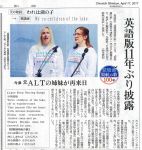
Chunichi Shimbun article (April 17, 2017) about our Lake Biwa Rowing Song mini concert held in Imazu on April 16, 2017. See videos of this event here: https://youtu.be/9G94IppUiiE
https://youtu.be/PjnY67sIcqE
|
|

Mainichi Shimbun article (April 17, 2017) about our Lake Biwa Rowing Song mini concert held in Imazu on April 16, 2017.
|
|
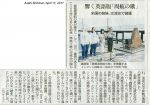
Asahi Shimbun article (April 17, 2017) about our Lake Biwa Rowing Song mini concert held in Imazu on April 16, 2017.
|
|

Sankei Shimbun article (April 17, 2017) about our Lake Biwa Rowing Song mini concert held in Imazu on April 16, 2017.
|
|

Yomiuri Shimbun article (April 17, 2017) about our Lake Biwa Rowing Song mini concert held in Imazu on April 16, 2017.
|
|
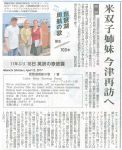
Mainichi Shimbun article (April 12, 2017) announcing our upcoming Lake Biwa Rowing Song mini concert to be held in Imazu on April 16, 2017.
|
|
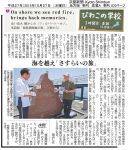
Kyoto Shimbun article mentioning the song's roots in the UK, May 27, 2015
|
|

"Lake Biwa Rowing Song CD on sale," June 17, 2007, Asahi Shimbun, Shiga Edition.
|
|

"Lake Biwa Rowing Song sung during Lake Biwa Cruise," June 17, 2007, Kyoto Shimbun, Shiga Edition.
|
|

"Lake Biwa Rowing Song photo exhibition at Imazu," June 5, 2007, Chunichi Shimbun, Biwako Edition
|
|

"Biwako Shuko no Uta in English, Beloved Song Translated" at Yokaichi Public Library, May 15, 2007, Shiga Hochi Shimbun 滋賀報知新聞
|
|

"Lake Biwa Rowing Song photo exhibition at Yokaichi Public Library," (Letter to the Editor), May 26, 2007, Kyoto Shimbun.Written by Masahiro Beniya.
|
|

"Japanese speech contest by foreigners in Shiga," Feb. 26, 2007, Chunichi Shimbun, Chunichi-Shiga pageWon by Jamie Thompson for her speech about Lake Biwa Rowing Song.
|
|

"13 contestants in Japanese speech contest by foreigners in Shiga," Feb. 26, 2007, Kyoto Shimbun, Shiga News
|
|
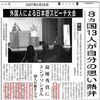
"Japanese speech contest by foreigners in Shiga, Ms. Thompson wins," Feb. 26, 2007, Mainichi Shimbun, Shiga Edition
|
|

"Lake Biwa Rowing Song photo exhibition in Takashima," June 12, 2006, Chunichi Shimbun, Chunichi-Shiga page. (The man in the picture is not Philbert.)
|
|
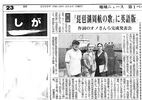
"Lake Biwa Rowing Song completed in English and performed in public," June 4, 2006, Mainichi Shimbun, Shiga News
|
|
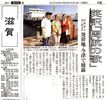
"Lake Biwa Rowing Song performed in public in Imazu, the song's birthplace," June 4, 2006, Yomiuri Shimbun, Shiga News
|
|
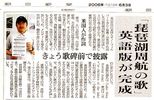
"Lake Biwa Rowing Song completed in English by an American," June 3, 2006, Asahi Shimbun, Shiga News
|
|
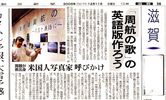
"Let's make an English version of Biwako Shuko no Uta," Dec. 11, 2005, Asahi Shimbun, Shiga News
|
|
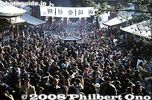
Crowd during New Year's
|
|

I always visit a different shrine on New Year's Day, so for 2009, I visited Atsuta Jingu Shrine in Nagoya. JR Atsuta Station on the Tokaido Line is one train station near Atsuta Jingu Shrine. JR熱田駅
|
|

Shopping arcade on the way to the shrine from Atsuta Station.Atsuta Jingu is near Meitetsu Jingumae Station, JR Atsuta Station on the Tokaido Line, Atsuta Jingu Nishi Station (renamed from Jingu Nishi Station on Jan. 4, 2023) on the Meijo subway line, and Atsuta Jingu Tenma-cho Station (renamed from Tenma-choStation on Jan. 4, 2023) on the Meijo subway line.
|
|

Another train station near Atsuta Shrine is Meitetsu Jingumae Station (this is closer than Atsuta Station). 名鉄神宮前駅
|
|

The road in front of Meitetsu Jingumae Station was closed to traffic, allowing pedestrians to get to Atsuta Shrine on New Year's Day.
|
|

Atsuta Jingu is one of Japan's most important shrines as it enshrines one of the three Imperial Regalia of Japan, the sacred (and perhaps legendary) sword called Kusanagi-no-Tsurugi ("Grass Cutting Sword"). 草薙の剣
|
|

Many food stalls line the way to the shrine on New Year's Day.
|
|

One normal gate was closed and we all had to enter through the East Gate.
|
|

The East torii gate of Atsuta Jingu Shrine, made of wood. Atsuta Jingu worships Atsuta-no-Ookami or Amaterasu-Omikami, the Sun Goddess represented by Kusanagi-no-tsurugi, the sacred sword.
|
|

This is where the crowd begins on New Year's Day. The shrine also worships four other deities: Susanoo-no-mikoto, Yamato-Takeru-no-Mikoto, and Takeinadane-no-Mikoto and Miyasuhime-no-Mikoto, the parents of the Owari natives (Nagoya area).
|
|

Banner read "Happy New Year."
|
|

Atsuta Shrine was established about 1900 years ago. In the centuries past, the shrine has been patronized by major historical figures such as Oda Nobunaga, Toyotomi Hideyoshi, and the Tokugawa shoguns (Ieyasu was originally from this area).
|
|

We soon hit a bottleneck where we had to wait a while as we slowly got nearer to the shrine.
|
|

We got to the wash fountain to purify ourselves.
|
|

From the ladle, pour the water into your hand and sip the water to purify yourself before visiting the shrine. This was a most crowded place.
|
|

Wash fountain
|
|

The crowd thickens and it was stop and go, repeatedly.
|
|

Barrels of sake.
|
|

We stand still.
|
|

We want to go straight.
|
|

Finally, the shrine is in sight.
|
|

Approaching the final torii.
|
|

The police were holding back the crowd at regular intervals before they could enter the shrine's worship area.
|
|

Now we stand in line to pray before the shrine.
|
|

Standing in line to pray.
|
|
|
|

Getting closer.
|
|
|

This is what we wanted to see. The offertory pit where people throw their money in front of the Hongu main shrine. 本宮
|
|

New Year's prayers at Atsuta Jingu Shrine on Jan. 1.
|
|
|

Coins, bills, gift certificates, and even wallets were thrown in here.
|
|
|
|
|

The shrine's bank will love to count all this money. It must be their favorite time of year.
|
|

I wonder how much money these wallets contain.
|
|

View of the money pit as seen from the shrine. This is still quite small compared to Meiji Shrine in Tokyo on New Year's Day. Less crowded too.
|
|

Atsuta Jingu Shrine's Hongu main shrine. For 1,000 yen, they let you in here to pray. The architecture and layout are almost the same as the Ise Grand Shrines in Mie Pref. Rebuilt in 1955. I wonder if the sacred sword is in there.
|
|
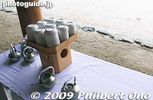
They also give you a small dish and sake served by a shrine maiden as you exit.
|
|

This is what we received for 1,000 yen. Some sweets as well. It also included a tea session. (See below.)
|
|

Shrine amulets were selling like crazy.
|
|

Shrines are in the business of selling good fortune and hope.
|
|

Votive tablets and other trinkets.
|
|
|
|

Description of various amulets in English.
|
|
|
|
|

Omikuji fortune paper.
|
|

Built in 1686 by Shogun Tsunayoshi, this is Nishi-gakusho, one of the few shrine buildings remaining from before the Meiji Period. Dances and other ceremonies are held here. 西楽所
|
|

Remnant of the Nobunaga-bei, a roofed mud wall donated to the shrine in 1560 by Oda Nobunaga in gratitude for his victory at the Battle of Okehazama.
|
|

Follow the sign to exit or to see other shrine buildings.
|
|

Homotsukan Treasure Hall houses and exhibits the shrine's valuable artifacts, including Important Cultural Properties and a National Treasure (a dagger). Many people donated stuff to the shrine, especially swords. 宝物館
|
|

Behind and attached to the Homotsukan Treasure Hall is the Bunkaden Culture Hall where they held a tea session. People form a long line as they wait to enter the Bunkaden. The tea was included in the 1,000 yen I paid to see the inner shrine.
|
|

This is the Bunkaden Culture Hall which is behind and attached to the Treasure Hall. This is where they held the tea session.
|
|

Inside the Bunkaden Culture Hall for tea.
|
|

The stage was appropriate for New Year's.
|
|

There was no ceremony. We just sat and were served tea and sweet.
|
|

A sweet confection to eat with the matcha tea.
|
|

The shrine maidens came around to serve the tea and sweet.
|
|

My bowl of matcha green tea. After we consumed the tea, we just left. The shrines also has many other buildings, but it was too crowded for me to see them all this day. I was too tired walk around more.
|
|

On approach to New Chitose Airport on an Air Do Boeing 767.
|
|

Landing on New Chitose Airport's runway 19L from a northerly approach.
|
|

Hello Hokkaido, it's been a long time since I've been here.
|
|

Arrival at the New Chitose Airport terminal.
|
|

The baggage crew worked very quickly. That's my bag rolling off the plane while I was still sitting in my seat waiting to get off.
|
|

New Chitose Airport, Hokkaido's main gateway, is the first place you see G8 Hokkaido Toyako Summit Welcome signs as we get off the plane.
|
|

Air Do Boeing 767 at New Chitose Airport.
|
|

New Chitose Airport, another Welcome sign as we head for the baggage claim area.
|
|

New Chitose Airport, another Welcome sign as we head for the baggage claim area.
|
|

Inside New Chitose Airport's Central Plaza, more G8 Hokkaido Toyako Summit Welcome signs.
|
|

Inside New Chitose Airport's Central Plaza, more G8 Hokkaido Toyako Summit Welcome signs.
|
|

New Chitose Airport's Central Plaza
|
|

New Chitose Airport's beautiful Central Plaza.
|
|

New Chitose Airport's Central Plaza
|
|

New Chitose Airport's Central Plaza
|
|

Inside New Chitose Airport's Central Plaza, G8 Hokkaido Toyako Summit countdown.
|
|

Inside New Chitose Airport at the check-in terminal, more G8 Hokkaido Toyako Summit Welcome signs.
|
|

The airport has a huge shopping area full of gift shops.
|
|

G8 Hokkaido Toyako Summit merchandise. They all seem to be unofficial goods. They don't bear the official logo.
|
|

Ramen shop sign.
|
|

New Chitose Airport terminal
|
|

Going through the boarding gate at New Chitose Airport, Hokkaido.
|
|

Ze plane...
|
|

On the boarding bridge to the plane. Notice the G8 Hokkaido Toyako Summit Welcome signs.
|
|

In my seat. Calbee is a sponsor, selling potatoes and potato chips.
|
|

Rainy night for take-off.
|
|

Bye-bye Hokkaido...
|
|
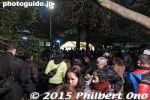
On New Year's Eve, Gotokuji temple allows people to ring the temple bell to ring out the old year in a ceremony called Joya-no-kane.
|
|
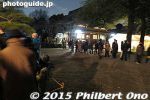
The line of people got longer and longer as midnight approached.
|
|
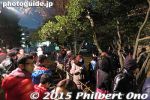
Quite a few people braved the cold to ring the temple bell on New Year's Eve on Dec. 31, 2014.
|
|
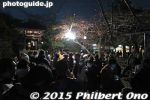
Temple bell in sight. Had to wait about an hour.
|
|
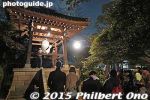
Gotokuji's temple bell on New Year's Eve.
|
|

Ringing Gotokuji's temple bell on New Year's Eve.
|
|
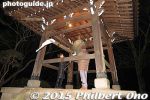
Each person got to ring the bell only once.
|
|
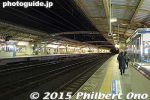
Gotokuji Station on early New Year's morning.
|
|
|
|
|
|
|
|
|
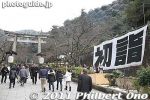
Sign reads, "Hatsumode" or New Year's worship.
|
|
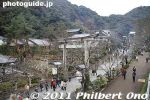
The first torii to the shrine.
|
|
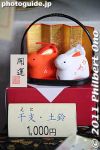
For the Year of the Rabbit.
|
|
|
|
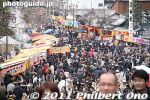
Pretty crowded, but it proceeded smoothly.
|
|
|
|
|
|
|
|
|
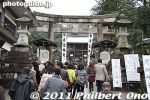
From here, we had to wait in line.
|
|

The second torii.
|
|
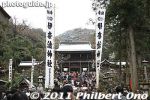
Banners read Inaba Shrine.
|
|
|
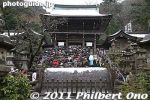
Arched bridge too steep to cross over.
|
|
|
|
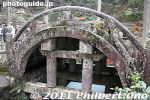
Inaba Shrine's taiko bridge. 神橋
|
|
|
|
|
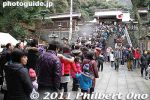
We had to wait a while...
|
|
|
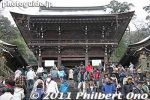
Romon Gate 楼門
|
|
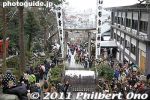
View from Romon Gate.
|
|
|
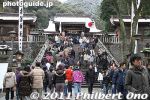
The line proceeded fast enough.
|
|

Approaching another gate called Shinmon. 神門
|
|
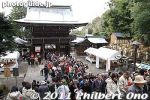
View of Romon Gate from Shinmon Gate.
|
|

Inaba Shrine's Haiden Hall was where we could pray.
|
|
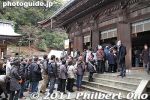
Lining up to pray at Haiden Hall.
|
|
|
|
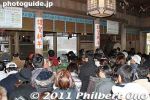
Inside Inaba Shrine's Haiden Hall.
|
|
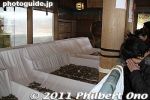
Offertory box
|
|
|
|
|
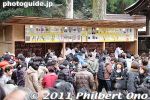
People buying good luck charms.
|
|
|
|
|
|
|
|
|
|
|
|
|
|
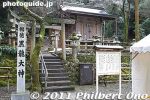
Inaba Shrine has a few other lesser shrines.
|
|
|
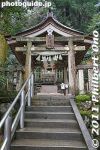
黒龍社
|
|
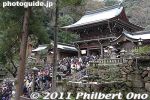
Romon Gate side view.
|
|
|
|
|
|
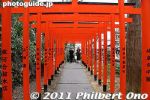
Inari Shrine torii. 楓稲荷神社
|
|
|
|
|
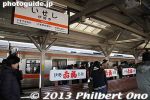
Ise-shi Station platform upon arrival on Jan. 1, 2013. Ise Jingu's Geku Outer Shrine is a short walk from this station.
|
|
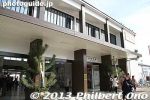
Ise-shi Station with kadomatsu New Year's decorations.
|
|

Bus stop for Naiku Inner Shrine. This is near Ise-shi Station.
|
|
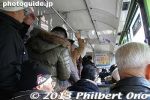
Inside the bus going to Naiku from Ise-shi Station.
|
|
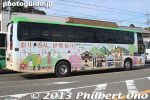
Colorful bus at Ise.
|
|
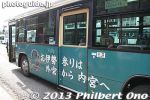
Bus with motif promoting Ise. Going to worship at Ise Jingu is called "Ise-mairi."
|
|
|
|

Map of Ise Jingu's Naiku Shrine. First you cross Uji Bridge.
|
|
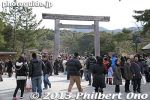
Torii gate at Uji Bridge. Very crowded with New Year's worshippers going for hatsumode prayers.
|
|
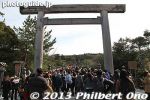
Ise Jingu Shrine's Naiku (Inner Shrine) is the main and most popular shrine at Ise. The shrine is rebuilt every 20 years and 2013 will mark the completion of the new shrine to replace the old one built in 1993.
|
|

Ise Jingu Shrine's Naiku is officially named, "Kotaijingu" (皇大神宮). It worships Amaterasu Omikami 天照坐皇大御神, the ancestor of the Imperial Family and the tutelary kami of the Japanese people. Naiku was founded 2000 years a
|
|

Crossing Uji Bridge, a little over 100 meters long. 宇治橋
|
|

A guard watching over the crowd crossing Uji Bridge.
|
|
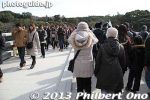
Uji Bridge is also rebuilt every 20 years.
|
|
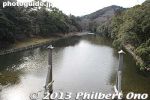
Uji Bridge goes over Isuzu River. 五十鈴川
|
|
|

The other end of Uji Bridge also has a torii gate.
|
|
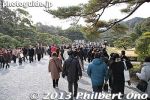
After crossing Uji Bridge, it is a gravel path to the shrine.
|
|
|
|
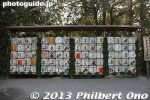
Barrels of sake as offerings.
|
|

Place to dispose of old decorations bought from the shrine.
|
|
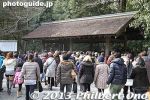
Water fountain where you wash your hands and rinse your mouth for purification. 手水舎
|
|
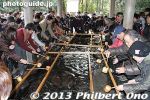
Before praying at the shrine, you're supposed to purify yourself. Wash your hands and rinse your mouth here. Use the ladle to pour water into your hand, then sip the water from your hand. Don't sip the water directly from the ladle. 手水舎
|
|
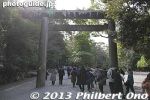
The first torii or Daiichi torii.
|
|
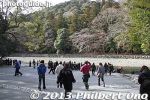
Another place to purify yourself on the banks of Isuzu River at this place called the Mitarashi. 五十鈴川と御手洗場
|
|

Dip your hands here in Isuzu River. Auto maker Isuzu was named after this crystal-clear river. 五十鈴川と御手洗場
|
|
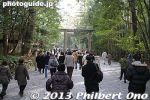
We could easily proceed from Uji Bridge to this Daini (Second) torii. So far so good.
|
|
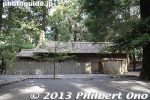
Horse stable.
|
|
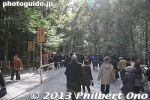
Still walking at a good pace.
|
|
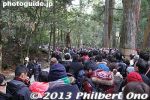
About 300-400 meters to the Naiku shrine, it got congested. It took about an hour to reach the foot of the steps going up to the shrine.
|
|
| 806 files on 4 page(s) |
1 |
 |
|